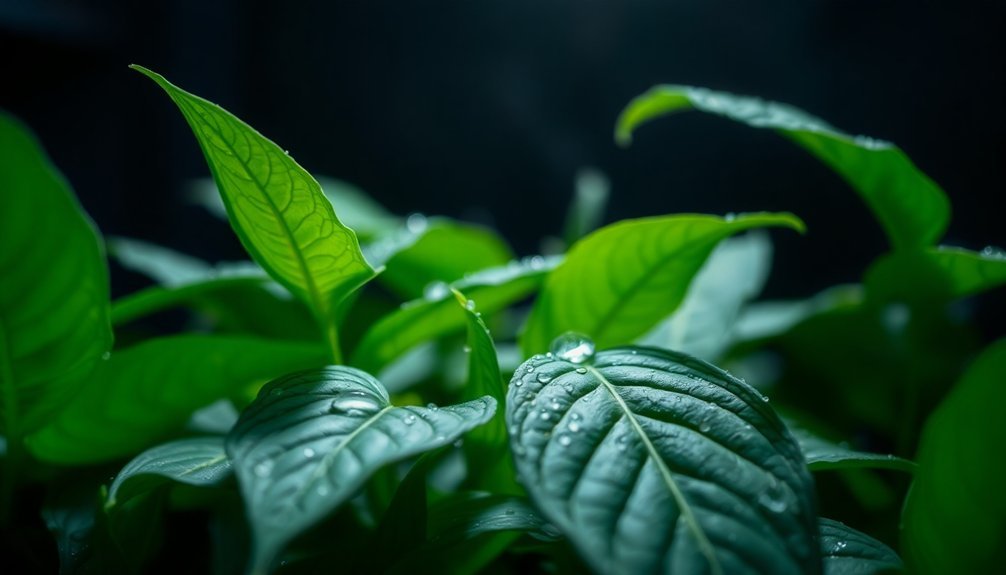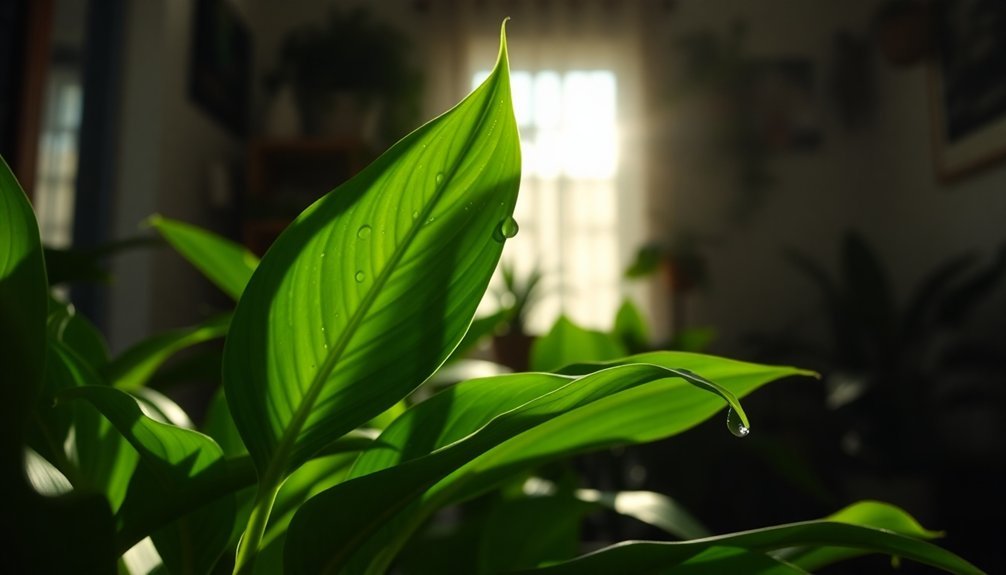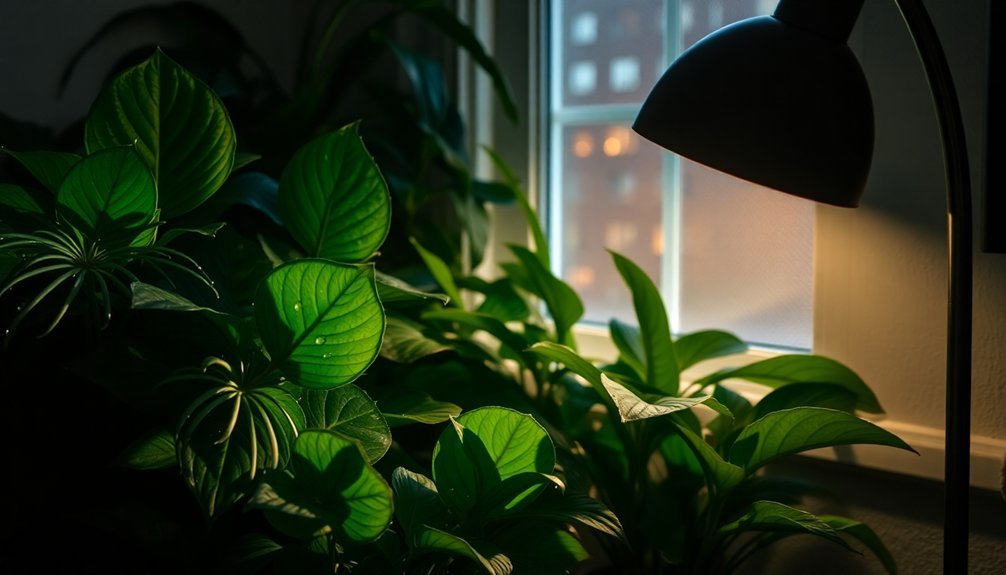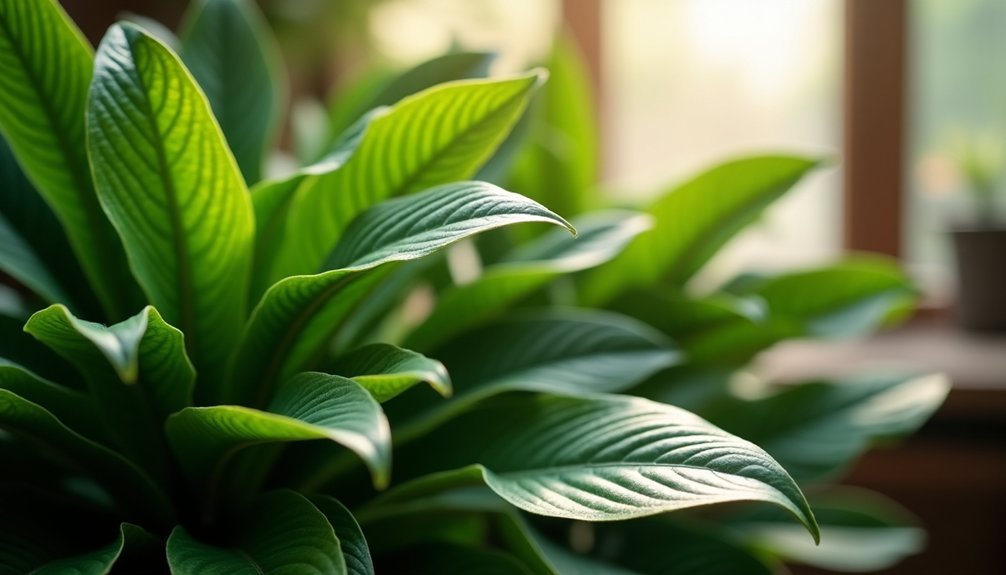Low-light plants have evolved specialized adaptations that make them incredibly effective at absorbing VOCs, even in dim conditions. You'll find they've developed larger leaves with higher chlorophyll concentrations and thicker mesophyll layers packed with chloroplasts. Their waxy cuticles trap harmful compounds, while their root systems partner with specialized microorganisms that break down toxins. These natural air purifiers work harder in darkness, making them perfect for improving your indoor air quality. Discover how these remarkable plants can transform your living space.
The Science Behind Low-Light Plant Adaptation

While most plants require abundant sunlight to thrive, some species have evolved remarkable adaptations for survival in low-light environments.
You'll find these plants have developed larger, broader leaves with higher chlorophyll concentrations to capture every available photon. Many plants employ Crassulacean Acid Metabolism to optimize photosynthesis in low light conditions. They've also mastered the art of leaf orientation, using heliotropism to track and maximize light exposure.
These adaptations aren't just surface-level changes. Inside their leaves, you'll discover a thicker mesophyll layer packed with chloroplasts, and their molecular machinery has been fine-tuned through specialized photosynthetic pathways.
They've even developed sophisticated shade tolerance mechanisms, including modified gene expression and chloroplast structures. When light conditions change, these plants can quickly respond through active adaptations like chloroplast movement and photosystem modulation, ensuring ideal light absorption in challenging environments.
How Darkness Enhances VOC Absorption
You might be surprised to learn that plants don't need light to absorb volatile organic compounds (VOCs), as they can take in these pollutants through their cuticles – the waxy coating on their leaves.
Your indoor plants continue their air-cleaning work at night through non-stomatal pathways, where the leaf surface directly absorbs VOCs without requiring open stomata.
The darkness actually promotes increased microorganism activity in the plant's root zone, enhancing the overall VOC absorption process even when photosynthesis isn't occurring. Studies show that variations in light quality and conditions significantly affect how plants emit and process VOCs.
Non-Stomatal Uptake Mechanisms
Although plants primarily absorb volatile organic compounds (VOCs) through their stomata during photosynthesis, research has revealed several non-stomatal mechanisms that enhance VOC absorption, particularly in low-light conditions.
You'll find that root and soil microorganisms play an essential role in this process, as they can metabolize VOCs even when there's no light. These microorganisms work in harmony with the plant's cellular structure, where non-specific lipid transfer proteins in the cell wall facilitate VOC uptake and transport.
When VOCs enter the plant, they trigger sophisticated defense responses, including calcium influx and MAPK activation. This sets off a chain reaction that affects everything from photosynthesis to hormone balance. Recent high-quality research demonstrates that these defense mechanisms are most active during nighttime hours, making low-light plants particularly effective at VOC removal.
The plant-microbe partnership creates an efficient system that doesn't just rely on simple adsorption but maintains sustained VOC removal through multiple pathways.
VOC Absorption Through Cuticles
Since plants must continue purifying air even without light, their cuticles serve as essential absorption sites for VOCs during dark periods.
You'll find that the cuticle's unique structure, rich in waxes and cutin, doesn't depend on light to trap harmful compounds. In fact, plants like Zamioculcas zamiifolia show no difference in VOC removal between light and dark conditions.
What makes cuticles so effective is their lipid-rich composition. The waxy layers can account for up to 46% of total VOC uptake, as seen in Dracaena sanderiana's absorption of benzene.
When stomata close at night, you won't see any decrease in air purification – the cuticle's negative charge and hydrophobic nature continue attracting and holding VOCs, ensuring constant air cleaning regardless of lighting conditions.
Microorganism Activity Intensifies
When darkness falls, microorganisms in plant soil become powerful allies in VOC absorption. You'll find that these tiny organisms don't need light to effectively remove harmful compounds from your air. In fact, they're often more active during dark periods, continuing to break down VOCs while your plants rest.
The secret lies in the relationship between plants and soil bacteria. Your plant's roots release carbon into the soil, which feeds these microorganisms. They'll then use specific enzymes to metabolize various VOCs, even when the plant's photosynthesis stops.
This process is particularly noticeable in CAM plants like Zamioculcas zamiifolia, where VOC removal remains consistent regardless of lighting conditions. When you add materials like activated charcoal to the soil, you're creating an even better environment for these microorganisms to thrive and remove pollutants.
Top-Performing Low-Light VOC Fighters

You'll find several shade-loving plants that excel at removing VOCs from indoor air, with Chinese Evergreen and Peace Lily leading the pack through their impressive formaldehyde and benzene absorption.
These plants don't rely solely on light for VOC removal, as they can absorb toxins through their cuticles and root zones even in darkness.
While most plants perform better in bright conditions, these specific varieties maintain their air-purifying abilities in low light through a combination of stomatal uptake and microbial action in their root systems.
Shade-Loving Species Analysis
Despite the challenges of low-light conditions, several shade-loving plant species excel at removing volatile organic compounds (VOCs) from indoor air.
You'll find that plants like Dracaena deremensis and Sansevieria trifasciata have adapted specifically to thrive in low light while maintaining impressive VOC-filtering capabilities.
These shade-lovers have developed unique characteristics that make them efficient air purifiers. Their thicker leaves and specialized leaf structures help them absorb pollutants more effectively, while their increased foliage-to-pollen ratio enhances their VOC-removing abilities.
Species like Hoya carnosa and Fittonia argyroneura are particularly good at filtering out common household pollutants, including benzene, toluene, and octane.
Their enhanced chlorophyll content, especially chlorophyll b, allows them to maintain photosynthetic efficiency even in dim conditions while actively processing airborne toxins.
Best VOC-Absorbing Varieties
Several standout low-light plants excel at removing harmful VOCs while requiring minimal maintenance. The Snake Plant stands out as a top performer, eliminating five major toxins while thriving in dim conditions.
You'll find the Peace Lily and Pothos equally impressive, as they tackle multiple VOCs like formaldehyde, benzene, and xylene with minimal care requirements.
- Snake Plants purify your air 24/7, working silently to protect your family's health while you sleep.
- Peace Lilies act as natural air filters, creating a sanctuary of clean air in your bedroom or office.
- Pothos vines not only cleanse your air but add cascading beauty to dark corners where other plants won't survive.
Choose these powerhouse plants to create a healthier indoor environment without worrying about complex care routines or bright light requirements.
Light-Independent Absorption Mechanisms
While many assume plants need light to fight indoor pollution, their VOC-absorbing abilities actually continue around the clock through complex biological processes.
You'll find that plants work with beneficial microorganisms in their root zones to break down and metabolize harmful compounds, even in darkness.
When your plant absorbs VOCs through its leaves, it transfers these compounds to its root system, where specialized soil bacteria use them as a food source.
These microorganisms have specific enzymes that can break down various toxins. That's why you'll see consistent VOC removal whether your plant is in potting soil or hydroponic media.
This process explains why low-light plants are just as effective at purifying your air as their sun-loving counterparts, making them excellent choices for darker indoor spaces.
Root Zone Activity in Dark Environments
As plants adapt to dark environments, their root zones undergo significant changes in water uptake patterns and physiological responses. You'll find that roots actively redistribute water from wet to dry areas while adjusting their cellular pathways to maintain efficiency.
These adaptive strategies help plants excel at managing resources in low-light conditions.
In dark environments, you can observe remarkable root zone behaviors:
- Roots produce ABA hormones that trigger stomata closure and enhance water conservation, showing nature's incredible survival mechanisms.
- Root systems dynamically adjust their electrical properties through fascinating geochemical changes and root exudates.
- Plants brilliantly modify their xylem vessels and develop strategic suberisation patterns, demonstrating their resourceful adaptation abilities.
The root zone's activity directly influences the plant's ability to maintain ideal water content between 70-80%, even during extended dark periods.
Microbial Partnerships Under Low Light

The intricate world of root zone activity extends beyond the plant itself to encompass remarkable microbial partnerships. You'll find that plants under low light conditions forge beneficial relationships with specific bacteria and fungi to enhance their growth and survival. When your plants face light limitations, they modify their root exudates to attract helpful microbes – it's like sending out a chemical SOS signal.
| Microbial Type | Function | Light Response |
|---|---|---|
| Root Bacteria | Growth Enhancement | Increases Activity |
| Beneficial Fungi | Nutrient Exchange | Adapts Community |
| Oomycetes | Resource Mobilization | Shifts Population |
| Defense Microbes | Pathogen Protection | Reduces Activity |
These partnerships aren't static – they're dynamic relationships that shift based on light conditions. Your plant's defense mechanisms may decrease under low light as it prioritizes growth, but the right microbial community helps maintain an essential balance between development and protection.
Health Benefits of Shade-Tolerant Purifiers
Plants capable of thriving in low-light conditions offer remarkable health benefits beyond their aesthetic appeal.
These shade-tolerant species, particularly Sansevieria Trifasciata, can effectively absorb harmful VOCs like formaldehyde and benzene, outperforming many air purifiers.
You'll find they're especially valuable in reducing your exposure to carcinogens and protecting your family's health.
- They help prevent serious health issues, including cancer, asthma, and chronic headaches by actively removing toxic compounds from your indoor air.
- You'll experience improved cognitive function and mental clarity as these plants reduce airborne pollutants that contribute to brain fog.
- Your immune system benefits from decreased exposure to harmful chemicals, leading to better overall health and reduced risk of respiratory problems.
These natural purifiers work tirelessly to create a healthier living environment, even in dimly lit spaces.
Optimal Placement for Maximum VOC Removal

Where you position your low-light air-purifying plants can greatly impact their VOC-removing effectiveness. You'll want to place them near common VOC sources, such as your kitchen, bathroom, or areas with new furniture.
However, don't isolate them in sealed spaces, as proper air circulation is essential for ideal performance.
Make sure you're giving each plant enough room to breathe by avoiding overcrowding. While these plants can tolerate low light, positioning them in moderate indirect light can enhance their VOC-removing capabilities since this helps keep their stomata open.
Keep the temperature consistent and consider the humidity needs of specific plants – for instance, if you're using Boston Ferns, they'll need higher humidity to effectively remove VOCs.
Remember to use quality potting media, as the microorganisms in the soil play a significant role in VOC removal.
Maintaining Air-Purifying Plants in Low Light
Once you've positioned your air-purifying plants strategically, maintaining them in low-light conditions becomes your next focus.
ZZ-plants and Chinese Evergreens are your most forgiving options, thriving with minimal care and infrequent watering. While Peace Lilies and Pothos need more attention to moisture levels, they'll reward you with excellent VOC removal capabilities.
- Don't let low light fool you into overwatering – most air-purifying plants prefer their soil to dry between waterings.
- Watch for signs of stress like yellowing leaves or drooping stems, which signal it's time to adjust your care routine.
- Monitor your plants' growth and fertilize monthly with a balanced liquid fertilizer, reducing frequency during winter months.
Remember to maintain consistent conditions and use well-draining soil to prevent root problems in these low-light champions.
Frequently Asked Questions
Can Low-Light Plants Effectively Remove Smoke Particles From Cigarettes?
Yes, you'll find that low-light plants like Snake Plant, Golden Pothos, and English Ivy can effectively remove cigarette smoke particles and chemicals, but you'll need multiple plants to achieve noticeable results.
Do Artificial Lights Impact VOC Absorption Differently Than Natural Low Light?
Yes, your plants will absorb VOCs less effectively under artificial lights compared to natural low light. Artificial lighting's limited spectrum can reduce photosynthesis and chlorophyll production, impacting the plant's VOC-filtering abilities.
How Frequently Should Soil Be Replaced to Maintain Voc-Absorbing Microbial Communities?
You don't need a fixed schedule for soil replacement. Instead, monitor your soil's microbial diversity and activity regularly. Replace soil only when you notice decreased microbial health or increased VOC emissions in your testing.
Which VOCS Are Most Resistant to Removal by Low-Light Plants?
You'll find benzene is the most stubborn VOC for low-light plants to remove. It's consistently harder to eliminate than toluene or trichloroethylene, with removal rates as low as 0.03 mg/m3/m2/h.
Does Plant Size Affect VOC Absorption Rates in Low-Light Conditions?
Yes, you'll find that larger plants generally absorb more VOCs in low light, but it's not just size – factors like leaf area, root systems, and metabolic activity work together to influence absorption rates.
In Summary
You'll find that low-light plants are nature's perfect air purifiers, having evolved specialized mechanisms to thrive in darkness while efficiently removing VOCs from your indoor air. By understanding their unique adaptations and placing them strategically, you're not just adding greenery – you're creating a healthier living space. Keep these shade-loving champions well-maintained, and they'll continue cleaning your air even in the dimmest corners.
References
- https://greenplantsforgreenbuildings.org/wp-content/uploads/2014/09/Dela-Cruz-2014-review-on-phytoremediation-with-indoor-plants-2.pdf
- https://ntrs.nasa.gov/api/citations/19930073077/downloads/19930073077.pdf
- https://greenplantsforgreenbuildings.org/wp-content/uploads/2014/01/PlantsArtificialDaylight.pdf
- https://botany.one/2015/06/light-quality-volatile-emissions-and-plant-plant-interactions/
- https://drexel.edu/news/archive/2019/November/potted-plants-do-not-improve-air-quality/
- https://www.tutorchase.com/answers/igcse/biology/how-do-plants-adapt-to-low-light-conditions-for-photosynthesis
- https://www.sciencedaily.com/releases/2024/04/240408130633.htm
- https://phys.org/news/2021-05-crops.html
- https://newatlas.com/health-wellbeing/indoor-plants-no-effect-air-quality-in-home/
- https://en.wikipedia.org/wiki/Shade_tolerance





Leave a Reply